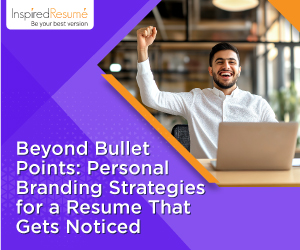The purpose of a resume isn't just to list qualifications; it's also to tell your story. Beyond the usual bullet points, personal branding helps you showcase what makes you unique, weaving together your strengths, experiences, and aspirations into a narrative that leaves a lasting impression.
Building a resume with a personal branding strategy means being intentional about how you present yourself. It’s more than highlighting skills; it’s about reflecting your personality and professional identity in a way that feels authentic. This approach allows you to connect with potential employers on a deeper level.
By incorporating storytelling and thoughtful design, you can turn a standard resume into a compelling introduction to who you are. It’s not just about getting noticed; it’s about being remembered for the journey that brought you here and the value you bring.
Looking for a professional Resume Assessment service? Get it here!
Crafting Your Personal Brand
Creating a personal brand involves recognizing individual strengths, defining career goals, and articulating a personal brand statement. This foundation can significantly enhance career opportunities.
Evaluating Personal Strengths and Skills
Identifying personal strengths and skills is the first step in personal branding. This evaluation helps clarify what makes an individual unique. They can start by listing their skills, experiences, and achievements.
Using a SWOT analysis (Strengths, Weaknesses, Opportunities, Threats) can provide deeper insight. This method highlights areas where they excel and aspects needing improvement. Resources like feedback from peers and performance reviews can aid in this process.
After identifying strengths, it’s crucial to match them with their desired job role. Focus on skills that are in high demand within their target industry. This alignment makes their personal brand more relevant and appealing to potential employers.
Get a customized Cover Letter INSTANTLY
Defining Your Career Aspirations
Clear career aspirations help shape and direct a personal brand. Individuals should outline both short-term and long-term goals. This clarity serves as a guide for the branding process.
Setting specific goals, such as desired job titles or companies, helps narrow focus. They can assess industry trends to ensure their aspirations align with future opportunities. Crafting a vision board can assist in visualizing these goals.
Regularly revisiting and revising these aspirations is essential. As skills develop and market conditions change, career aspirations may also evolve. This adaptability strengthens the personal brand by keeping it current and relevant.
Personal Brand Statement Development
A personal brand statement succinctly summarizes an individual’s skills, values, and aspirations. It serves as an elevator pitch for potential employers.
To create an effective statement, start with a template: “I am a [job title] who [unique value or skill]. I help [target audience] achieve [specific result].”
This structure helps articulate what sets them apart. It’s important to keep the statement concise and impactful. The statement should reflect personality and values, ensuring authenticity.
Revising the statement periodically allows for updates and improvements. This evolution is vital to maintaining relevance in a dynamic job market. A well-crafted personal brand statement can significantly enhance visibility in today’s competitive job landscape.
How to Craft a Skills-First Resume That Stands Out in 2025
Structuring Your Resume
A well-structured resume effectively highlights skills and experiences while incorporating personal branding elements. Attention to format, layout, and branding can significantly impact the first impression on potential employers.
Choosing the Right Resume Format
The choice of resume format sets the foundation for how information is presented. The three main formats are chronological, functional, and hybrid.
- Chronological: Lists work history in reverse order, ideal for those with a strong employment background.
- Functional: Focuses on skills and experiences rather than a timeline, suitable for career changers or those with gaps.
- Hybrid: Combines elements of both formats, allowing for flexibility and customization according to individual strengths.
Selecting the appropriate format depends on the individual’s career stage and industry norms.
Strategic Layout and Design Choices
The layout of a resume is crucial for readability. It should guide the reader’s eye to key information without overwhelming them.
- Use clear headings to define sections like Experience, Education, and Skills.
- Implement bullet points for easy scanning of information.
- Maintain consistent font styles and sizes, ideally a professional font like Arial or Times New Roman.
Incorporating white space enhances readability and allows the content to breathe, making it visually appealing.
Incorporating Branding Elements
Personal branding elements add a distinctive touch to a resume. These elements can include a professional logo, a unique color scheme, or a personalized summary statement.
- A logo can reinforce a personal brand, especially for creative professions.
- A specific color palette should be subtle yet distinctive, reinforcing brand identity.
- Including a tagline or summary statement at the top captures the essence of the candidate’s professional value.
These branding elements should complement the content, ensuring consistency throughout the resume. They create a memorable impression that aligns with the candidate’s professional persona.
Practical Tips for Career Advancement
Highlighting Key Achievements
Effective resumes spotlight key achievements that demonstrate an applicant's value. To stand out, it's essential to choose accomplishments wisely, quantify successes, and tailor information to align with job descriptions.
Selecting Impactful Accomplishments
Identifying the right achievements begins with evaluating past roles and responsibilities. Candidates should focus on accomplishments that had a significant impact on their teams or organizations.
Consider achievements like:
- Successful projects: Highlight projects that led to measurable outcomes.
- Leadership roles: Describe instances where leadership influenced team performance.
Prioritize achievements relevant to the job sought. This targeted approach will enhance the overall appeal of the resume.
Quantifying Successes
Quantifying achievements brings clarity and emphasizes the extent of one's impact. Metrics provide solid evidence of abilities and contributions.
Candidates should incorporate figures such as:
- Percentage increases: Show growth in sales or engagement.
- Cost savings: Highlight reductions in expenses achieved through strategic actions.
Using specific numbers helps create a vivid picture of success. It transforms vague statements into compelling evidence of capability and results.
Tailoring Content to Job Descriptions
Customizing resumes is a critical step in crafting a standout application. Candidates must align their achievements with the qualifications listed in job descriptions.
Identify keywords and responsibilities in the job posting. Then, adjust the resume to reflect these elements by:
- Incorporating relevant accomplishments: Use experiences that closely match the desired skills.
- Modifying language: Align wording with the terminology used in the job description.
This careful tailoring ensures the resume resonates with hiring managers and passes through applicant tracking systems, increasing the likelihood of selection for interviews.
Networking and Online Presence
A strong network and a well-crafted online presence are essential for personal branding. These elements help create visibility and credibility in the competitive job market.
Leveraging Social Media
Social media platforms are powerful tools for building a professional network. LinkedIn is particularly important, as it is designed for career-minded individuals.
1. Optimize Profiles: A complete and professional profile can attract potential employers. Use a clear profile picture, engaging headline, and comprehensive summary.
2. Engage with Connections: Actively participate in discussions, share relevant articles, and provide insights. This positions the individual as knowledgeable in their field and fosters relationships.
3. Expand Network Strategically: Connect with peers, industry leaders, and alumni. Sending personalized connection requests can increase the chances of forming meaningful connections.
Creating a Professional Online Portfolio
An online portfolio showcases skills and past work, making a compelling case for potential employers. It is a vital component of personal branding.
1. Choose the Right Platform: Options like WordPress, Wix, or GitHub can serve as effective hosting platforms. Select one that aligns with the profession.
2. Highlight Key Projects: Each project should be well-documented with narratives that explain roles, challenges, and achievements. Use visuals to enhance presentation.
3. Keep it Updated: Regularly update the portfolio with new achievements and projects. This practice demonstrates growth and keeps content relevant.
By focusing on these aspects, individuals can significantly enhance their visibility and attractiveness to potential employers.
Final Touches and Follow-Up
Attention to detail can greatly enhance a resume’s effectiveness. Polish your final draft through thorough proofreading, and maintain connections with potential employers through strategic follow-ups.
Proofreading and Editing Techniques
Effective proofreading ensures clarity and professionalism. Utilize the following techniques:
- Read Aloud: Hearing the words can help catch errors or awkward phrasing.
- Print It Out: A physical copy can reveal mistakes missed on a screen.
- Use Tools: Leverage software like Grammarly or Hemingway to catch grammatical issues.
- Peer Review: Ask a trusted friend or mentor to provide feedback and fresh perspective.
Focus on consistent formatting. Ensure headers, fonts, and bullet points are uniform. Pay special attention to spelling and punctuation, as these reflect attention to detail.
Effective Follow-Up Strategies
A thoughtful follow-up can reinforce interest and leave a strong impression. Consider these approaches:
- Timing: Send a follow-up email within 48 hours after submitting a resume or attending an interview.
- Express Gratitude: Thank the employer for their time and restate interest in the position.
- Additional Information: If appropriate, mention any new information that enhances qualifications or addresses a previous discussion.
- Keep it Brief: Limit the email to a few concise paragraphs. This helps maintain the reader's attention.
Setting reminders to follow up can help maintain professionalism and persistence without being intrusive.
Are you looking for a career change? READ HERE




